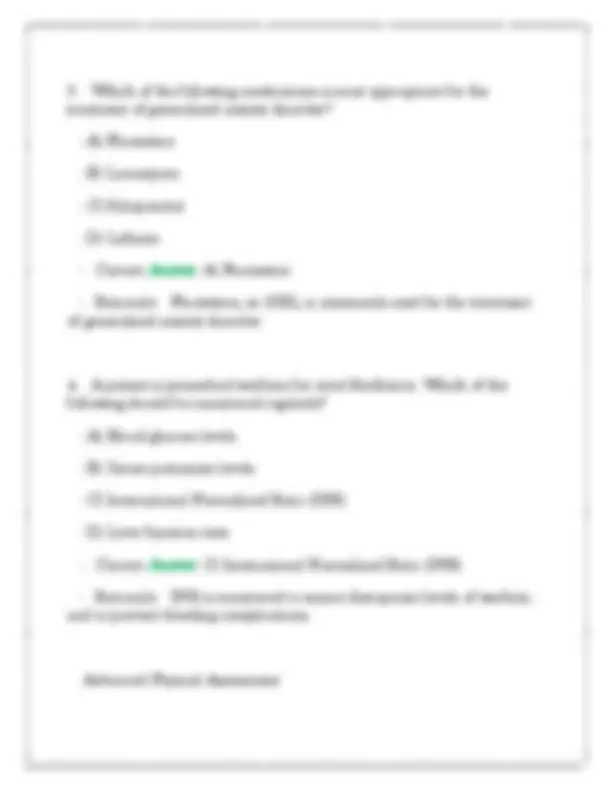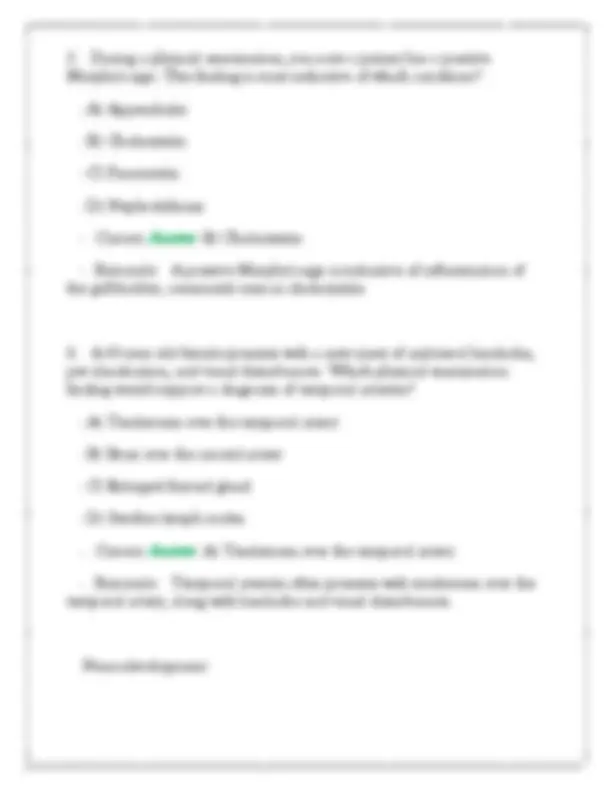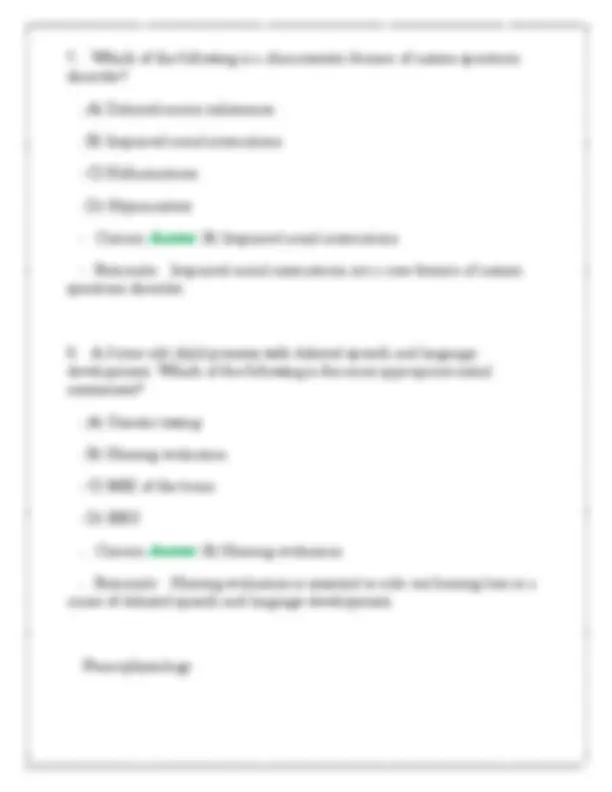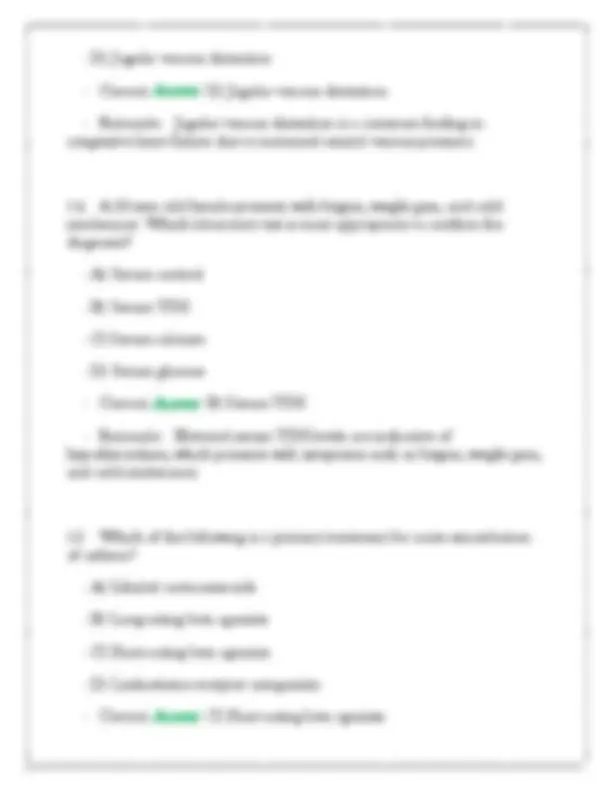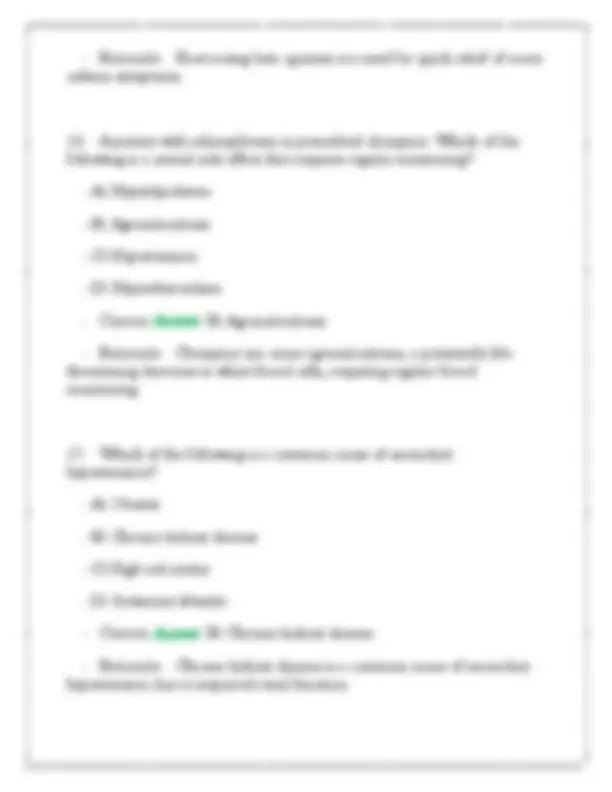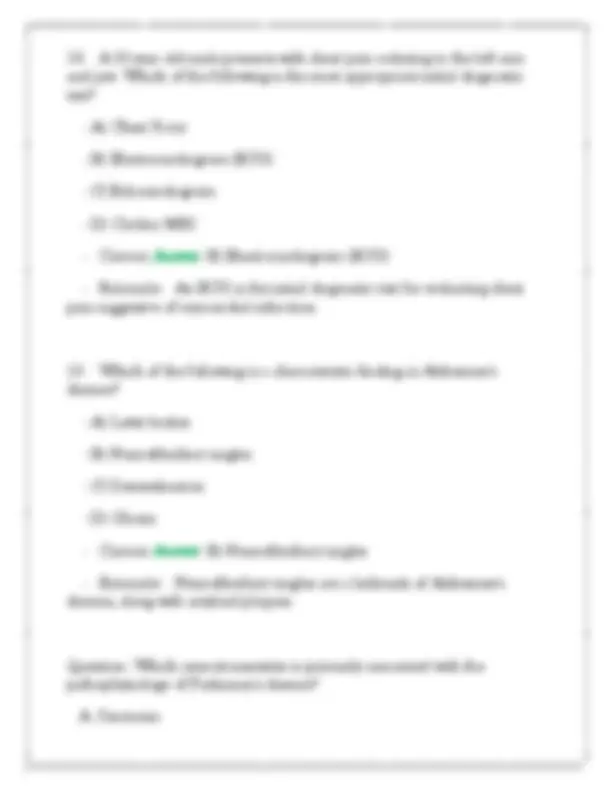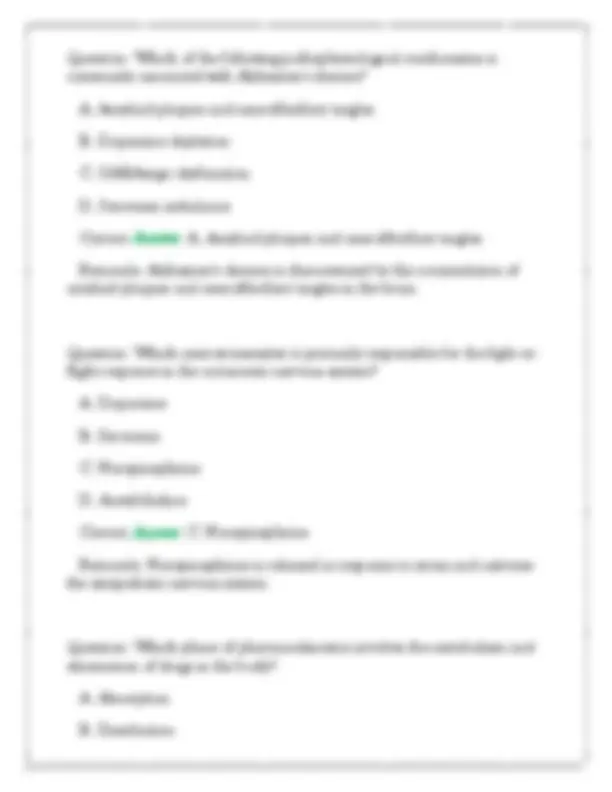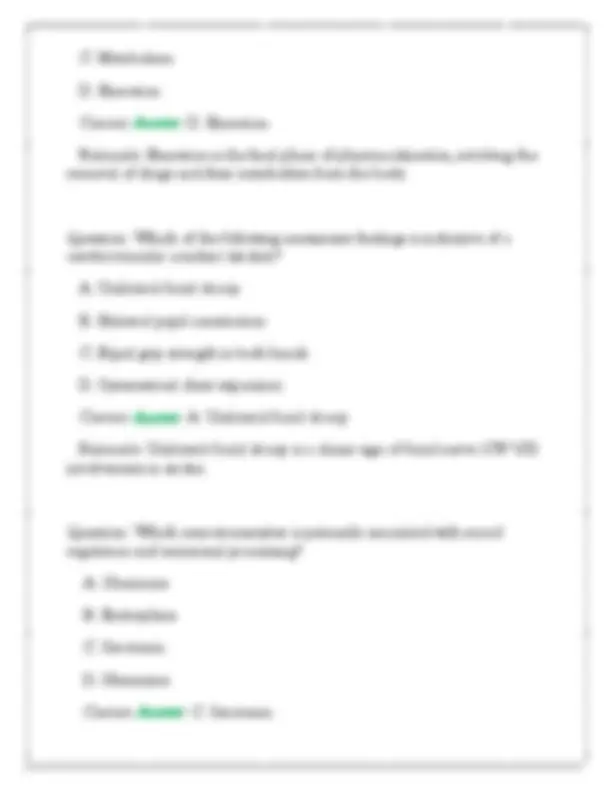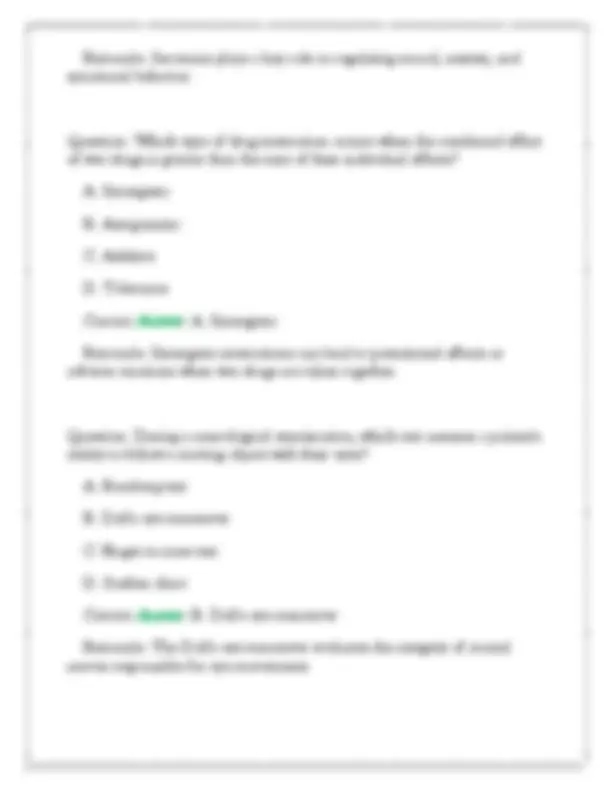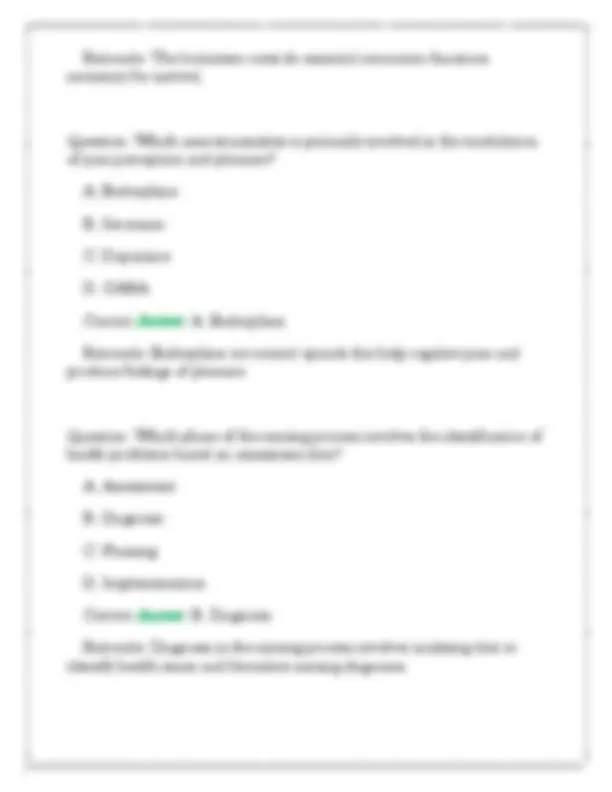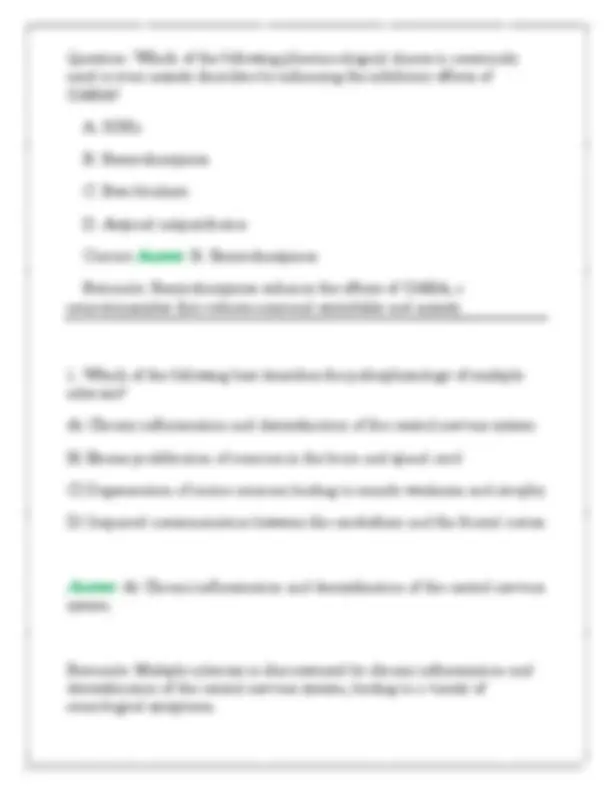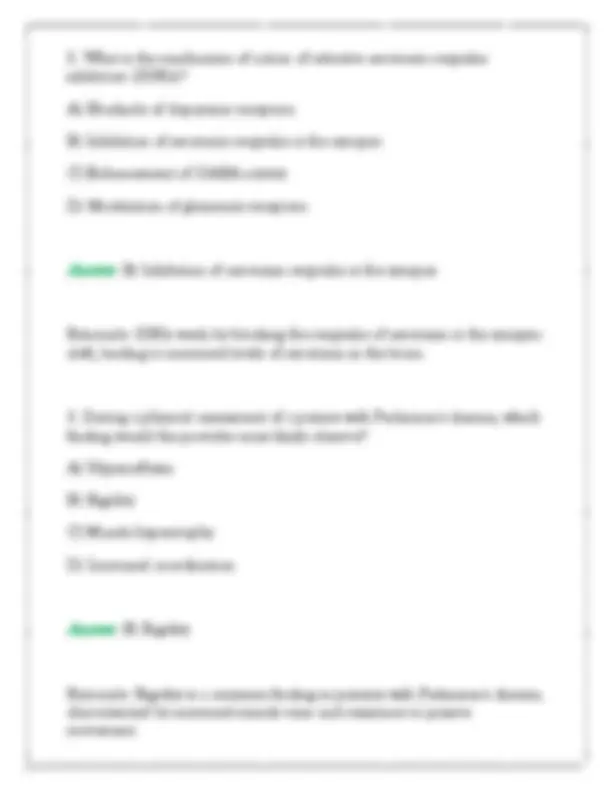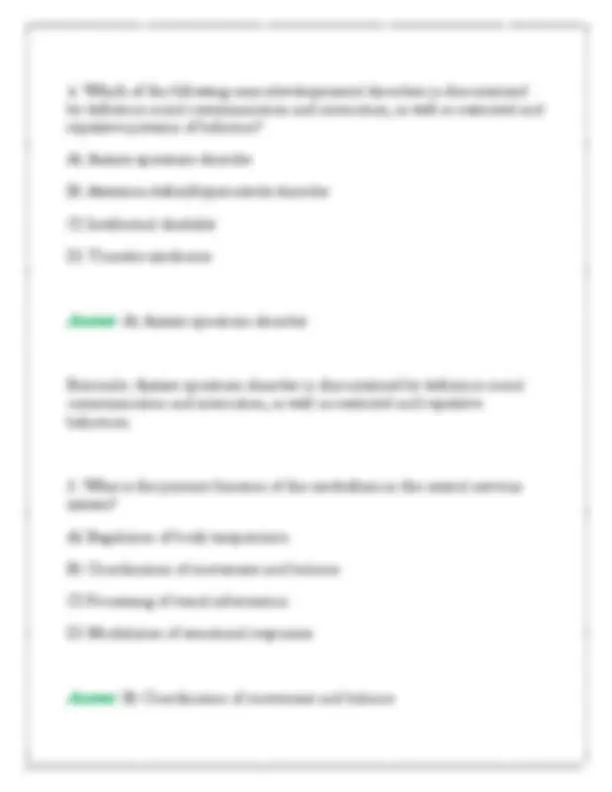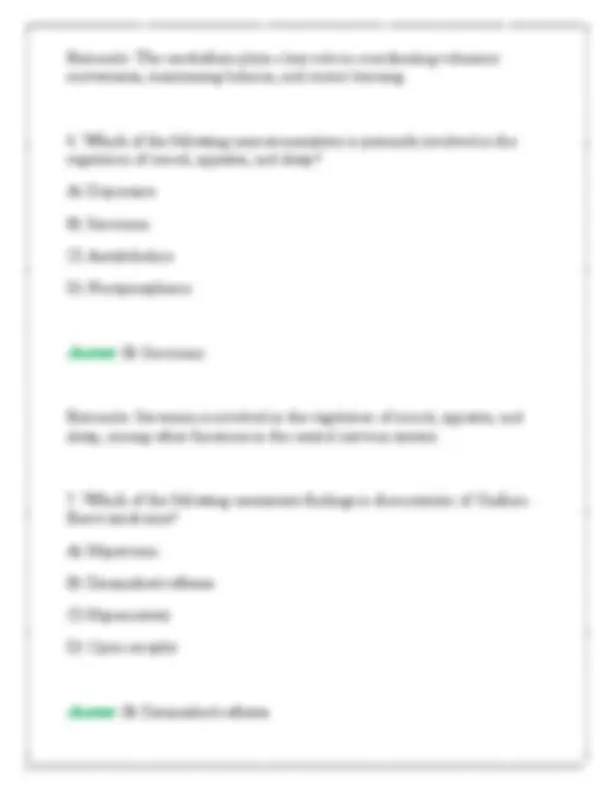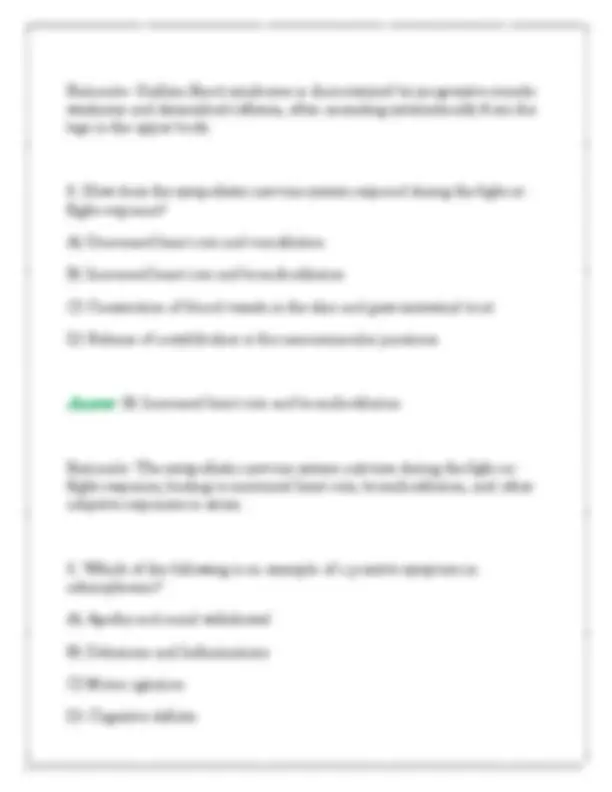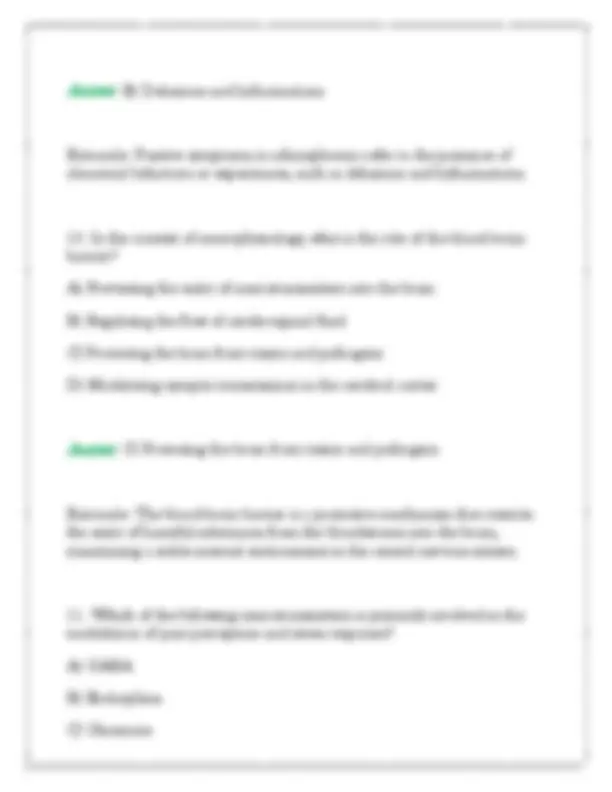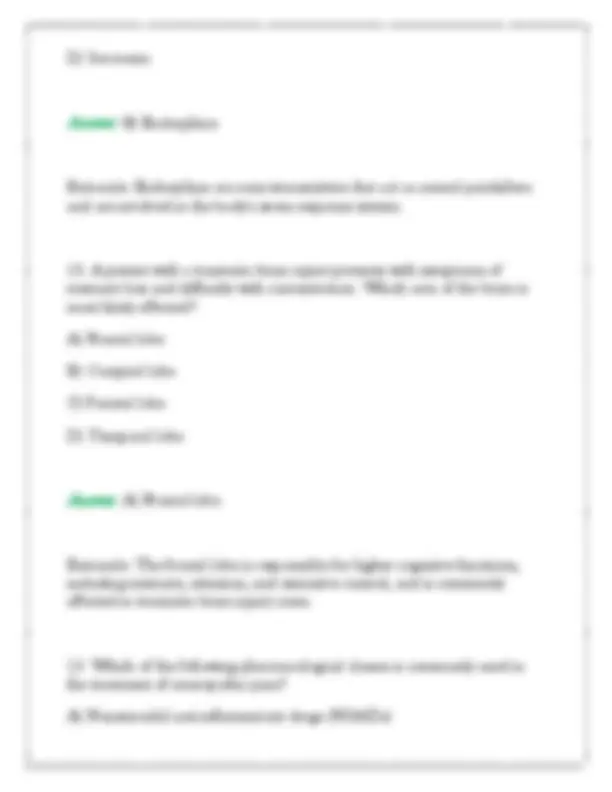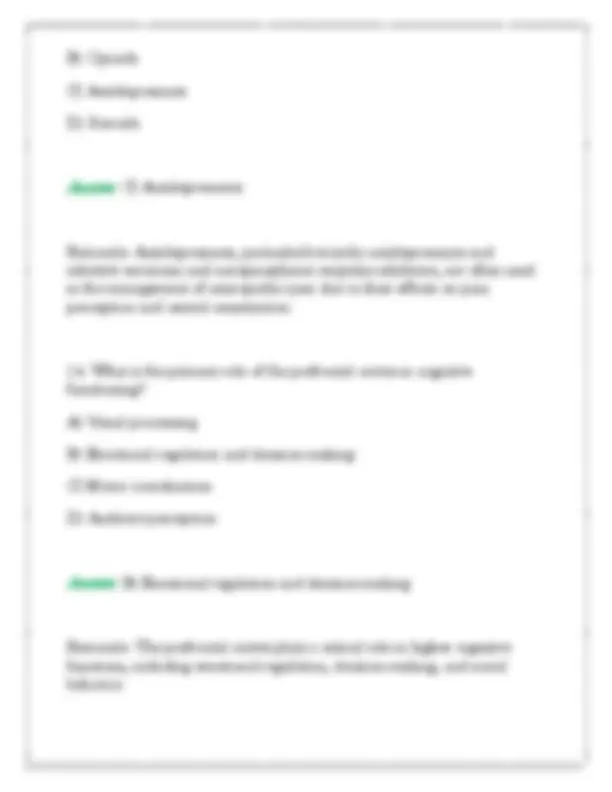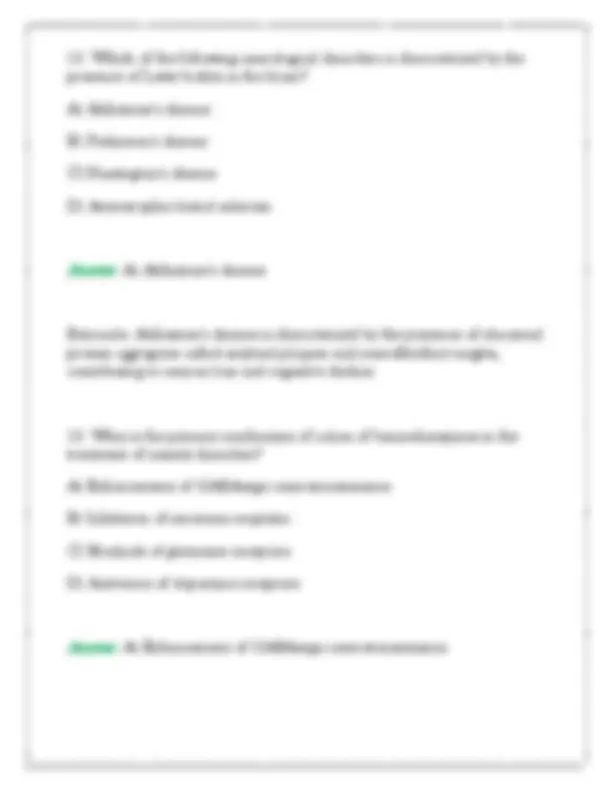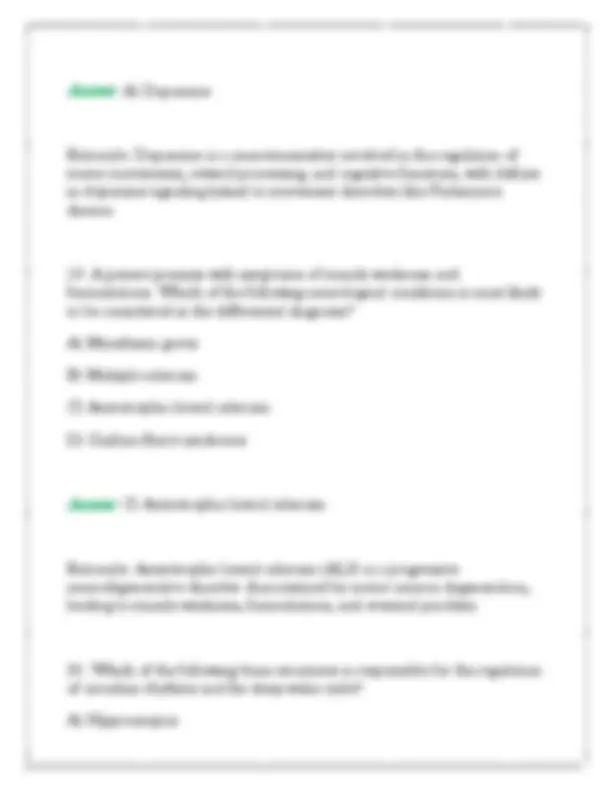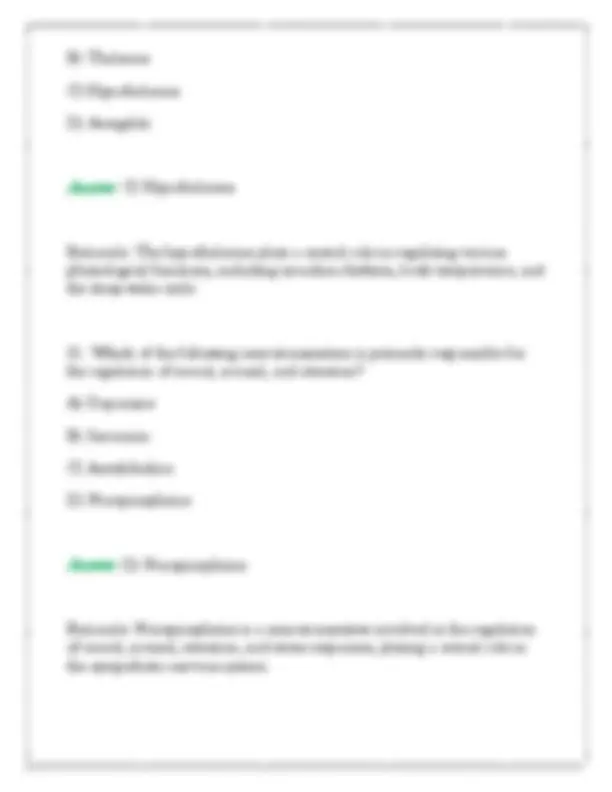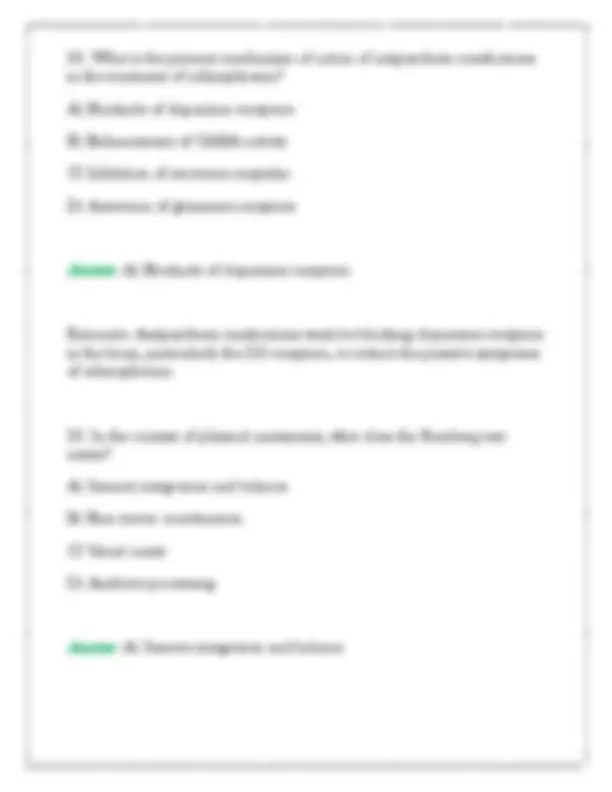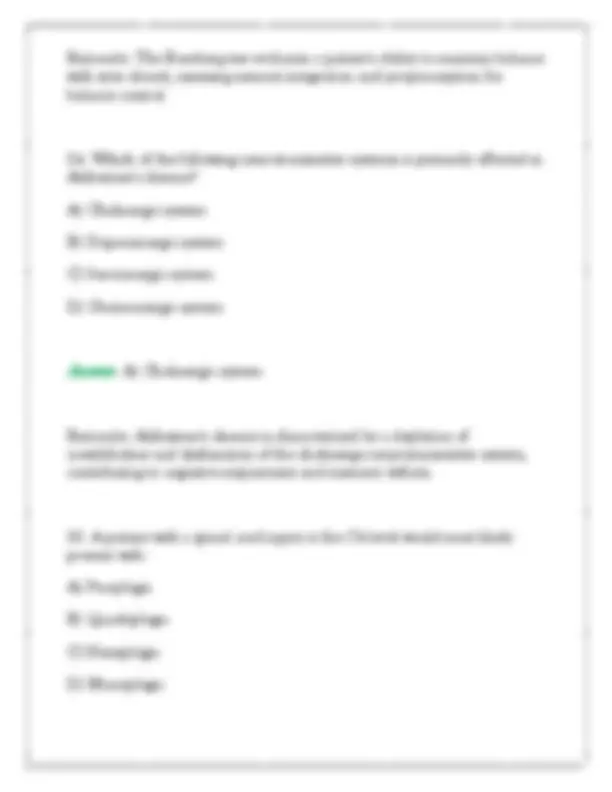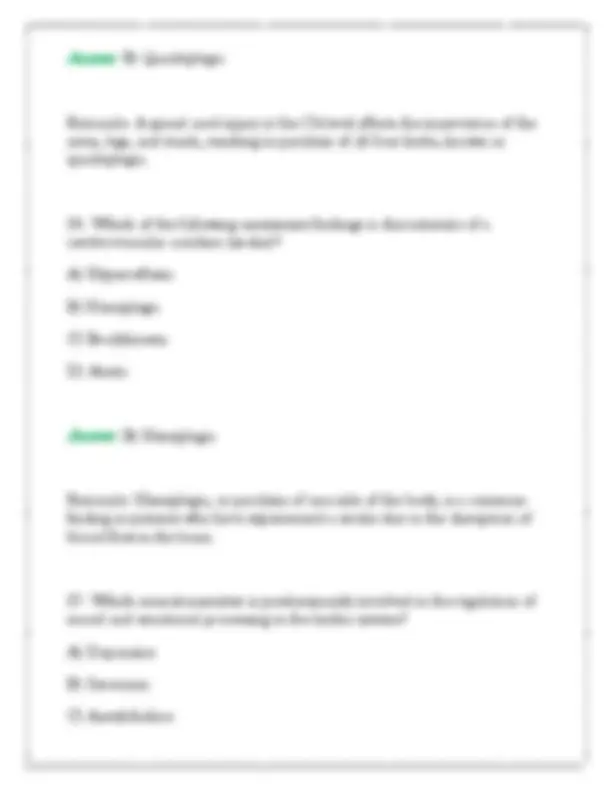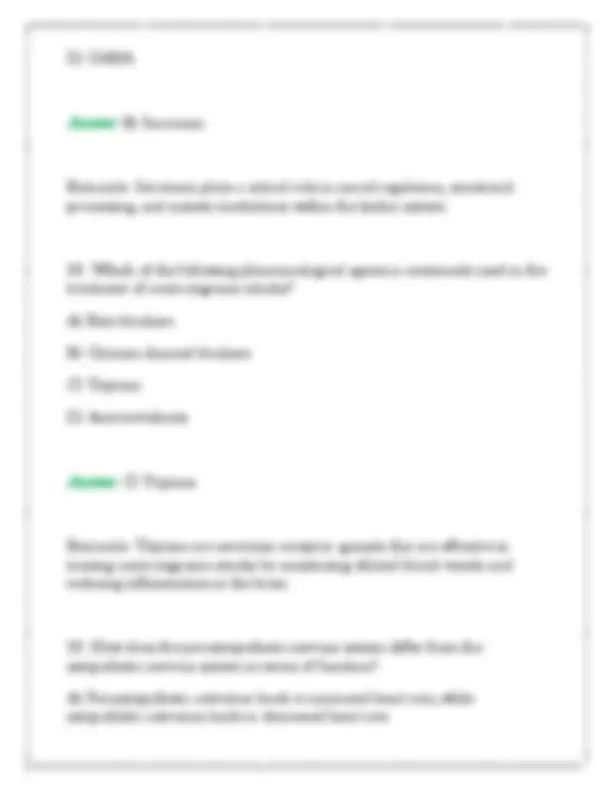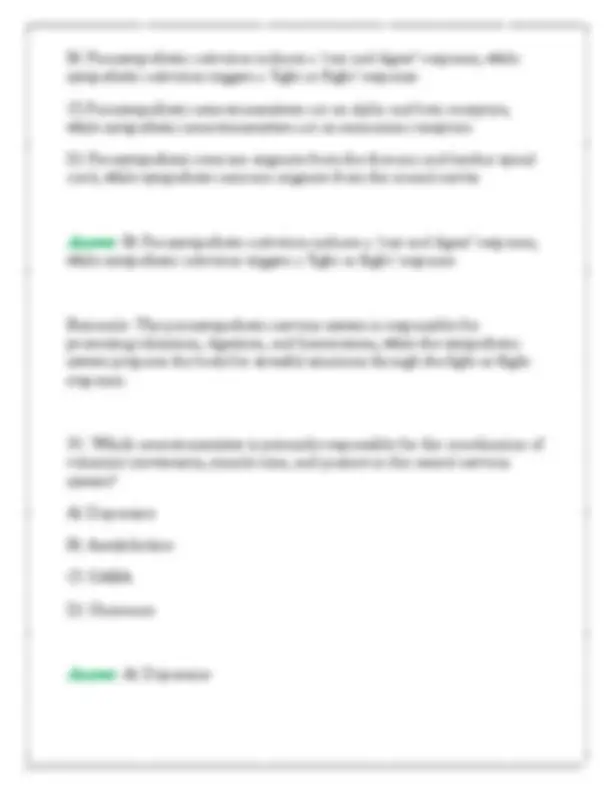Download ANCC-PMHNP Scientific Foundation Comprehensive Test Guide 2024 and more Exams Nursing in PDF only on Docsity!
PMHNP
Scientific Foundation
COMPREHENSIVE TEST GUIDE
- A 45-year-old male presents with chronic cough and weight loss. A chest X-ray reveals a mass in the right lung. Which of the following is the most likely diagnosis?
- A) Asthma
- B) Chronic bronchitis
- C) Lung cancer
- D) Tuberculosis
- Correct Answer: C) Lung cancer
- Rationale: The combination of chronic cough, weight loss, and a mass on chest X-ray is highly suggestive of lung cancer.
- A patient with a history of hypertension presents with sudden onset of severe headache, nausea, and vomiting. Which of the following is the most likely cause?
- A) Migraine
- B) Subarachnoid hemorrhage
- C) Tension headache
- D) Sinusitis
- Correct Answer: B) Subarachnoid hemorrhage
- Rationale: Sudden severe headache with nausea and vomiting in a hypertensive patient is indicative of a subarachnoid hemorrhage. Advanced Pharmacology
- During a physical examination, you note a patient has a positive Murphy's sign. This finding is most indicative of which condition?
- A) Appendicitis
- B) Cholecystitis
- C) Pancreatitis
- D) Nephrolithiasis
- Correct Answer: B) Cholecystitis
- Rationale: A positive Murphy's sign is indicative of inflammation of the gallbladder, commonly seen in cholecystitis.
- A 60-year-old female presents with a new onset of unilateral headache, jaw claudication, and visual disturbances. Which physical examination finding would support a diagnosis of temporal arteritis?
- A) Tenderness over the temporal artery
- B) Bruit over the carotid artery
- C) Enlarged thyroid gland
- D) Swollen lymph nodes
- Correct Answer: A) Tenderness over the temporal artery
- Rationale: Temporal arteritis often presents with tenderness over the temporal artery, along with headache and visual disturbances. Neurodevelopment
- Which of the following is a characteristic feature of autism spectrum disorder?
- A) Delayed motor milestones
- B) Impaired social interactions
- C) Hallucinations
- D) Hyperactivity
- Correct Answer: B) Impaired social interactions
- Rationale: Impaired social interactions are a core feature of autism spectrum disorder.
- A 3-year-old child presents with delayed speech and language development. Which of the following is the most appropriate initial assessment?
- A) Genetic testing
- B) Hearing evaluation
- C) MRI of the brain
- D) EEG
- Correct Answer: B) Hearing evaluation
- Rationale: Hearing evaluation is essential to rule out hearing loss as a cause of delayed speech and language development. Neurophysiology
- A) Hypertension
- B) Hyperglycemia
- C) Bradycardia
- D) Hypokalemia
- Correct Answer: B) Hyperglycemia
- Rationale: Antipsychotic medications can cause metabolic side effects, including hyperglycemia.
- A patient with a history of epilepsy presents with a new onset of rash and fever. Which antiepileptic drug is most likely responsible?
- A) Phenytoin
- B) Valproic acid
- C) Carbamazepine
- D) Lamotrigine
- Correct Answer: D) Lamotrigine
- Rationale: Lamotrigine is associated with a risk of serious skin reactions, including Stevens-Johnson syndrome.
- Which of the following physical examination findings is most consistent with a diagnosis of congestive heart failure?
- A) Hepatomegaly
- B) Splenomegaly
- C) Ascites
- D) Jugular venous distention
- Correct Answer: D) Jugular venous distention
- Rationale: Jugular venous distention is a common finding in congestive heart failure due to increased central venous pressure.
- A 25-year-old female presents with fatigue, weight gain, and cold intolerance. Which laboratory test is most appropriate to confirm the diagnosis?
- A) Serum cortisol
- B) Serum TSH
- C) Serum calcium
- D) Serum glucose
- Correct Answer: B) Serum TSH
- Rationale: Elevated serum TSH levels are indicative of hypothyroidism, which presents with symptoms such as fatigue, weight gain, and cold intolerance.
- Which of the following is a primary treatment for acute exacerbation of asthma?
- A) Inhaled corticosteroids
- B) Long-acting beta agonists
- C) Short-acting beta agonists
- D) Leukotriene receptor antagonists
- Correct Answer: C) Short-acting beta agonists
- A 50-year-old male presents with chest pain radiating to the left arm and jaw. Which of the following is the most appropriate initial diagnostic test?
- A) Chest X-ray
- B) Electrocardiogram (ECG)
- C) Echocardiogram
- D) Cardiac MRI
- Correct Answer: B) Electrocardiogram (ECG)
- Rationale: An ECG is the initial diagnostic test for evaluating chest pain suggestive of myocardial infarction.
- Which of the following is a characteristic finding in Alzheimer's disease?
- A) Lewy bodies
- B) Neurofibrillary tangles
- C) Demyelination
- D) Gliosis
- Correct Answer: B) Neurofibrillary tangles
- Rationale: Neurofibrillary tangles are a hallmark of Alzheimer's disease, along with amyloid plaques. Question: Which neurotransmitter is primarily associated with the pathophysiology of Parkinson's disease? A. Serotonin
B. Dopamine C. Acetylcholine D. GABA
Correct Answer: B. Dopamine
Rationale: Parkinson's disease is characterized by the degeneration of dopamine-producing neurons in the substantia nigra of the brain. Question: Which of the following classes of medications is commonly used in the treatment of bipolar disorder for mood stabilization? A. SSRIs B. Benzodiazepines C. Antipsychotics D. MAOIs
Correct Answer: C. Antipsychotics
Rationale: Antipsychotics are often prescribed to manage manic and mixed episodes in bipolar disorder. Question: During a physical assessment, which cranial nerve is responsible for controlling eye movements? A. Cranial Nerve V (Trigeminal) B. Cranial Nerve III (Oculomotor) C. Cranial Nerve VII (Facial) D. Cranial Nerve X (Vagus)
Question: Which of the following pathophysiological mechanisms is commonly associated with Alzheimer's disease? A. Amyloid plaques and neurofibrillary tangles B. Dopamine depletion C. GABAergic dysfunction D. Serotonin imbalance
Correct Answer: A. Amyloid plaques and neurofibrillary tangles
Rationale: Alzheimer's disease is characterized by the accumulation of amyloid plaques and neurofibrillary tangles in the brain. Question: Which neurotransmitter is primarily responsible for the fight-or- flight response in the autonomic nervous system? A. Dopamine B. Serotonin C. Norepinephrine D. Acetylcholine
Correct Answer: C. Norepinephrine
Rationale: Norepinephrine is released in response to stress and activates the sympathetic nervous system. Question: Which phase of pharmacokinetics involves the metabolism and elimination of drugs in the body? A. Absorption B. Distribution
C. Metabolism D. Excretion
Correct Answer: D. Excretion
Rationale: Excretion is the final phase of pharmacokinetics, involving the removal of drugs and their metabolites from the body. Question: Which of the following assessment findings is indicative of a cerebrovascular accident (stroke)? A. Unilateral facial droop B. Bilateral pupil constriction C. Equal grip strength in both hands D. Symmetrical chest expansion
Correct Answer: A. Unilateral facial droop
Rationale: Unilateral facial droop is a classic sign of facial nerve (CN VII) involvement in stroke. Question: Which neurotransmitter is primarily associated with mood regulation and emotional processing? A. Glutamate B. Endorphins C. Serotonin D. Histamine
Correct Answer: C. Serotonin
Question: Which neurotransmitter is primarily involved in the regulation of sleep-wake cycles and circadian rhythms? A. GABA B. Melatonin C. Glutamate D. Acetylcholine
Correct Answer: B. Melatonin
Rationale: Melatonin is a hormone that regulates the sleep-wake cycle and is produced by the pineal gland. Question: Which of the following assessment findings is consistent with a diagnosis of multiple sclerosis (MS)? A. Ataxia B. Hypertension C. Bradycardia D. Hyperreflexia
Correct Answer: A. Ataxia
Rationale: Ataxia, or lack of coordination, is a common symptom of multiple sclerosis due to demyelination of nerve fibers. Question: Which phase of the nursing process involves the systematic collection of patient data? A. Assessment B. Diagnosis
C. Planning D. Evaluation
Correct Answer: A. Assessment
Rationale: Assessment is the initial phase of the nursing process, where data about the patient's health status is gathered. Question: In pharmacology, what term describes the study of drug absorption, distribution, metabolism, and excretion in the body? A. Pharmacodynamics B. Pharmacokinetics C. Pharmacogenetics D. Pharmaceutics
Correct Answer: B. Pharmacokinetics
Rationale: Pharmacokinetics explores how the body processes drugs, including absorption, distribution, metabolism, and excretion. Question: Which area of the brain is responsible for regulating vital functions such as breathing and heart rate? A. Cerebellum B. Thalamus C. Hypothalamus D. Brainstem
Correct Answer: D. Brainstem
Question: Which of the following pharmacological classes is commonly used to treat anxiety disorders by enhancing the inhibitory effects of GABA? A. SSRIs B. Benzodiazepines C. Beta-blockers D. Atypical antipsychotics
Correct Answer: B. Benzodiazepines
Rationale: Benzodiazepines enhance the effects of GABA, a neurotransmitter that reduces neuronal excitability and anxiety.
- Which of the following best describes the pathophysiology of multiple sclerosis? A) Chronic inflammation and demyelination of the central nervous system B) Excess proliferation of neurons in the brain and spinal cord C) Degeneration of motor neurons leading to muscle weakness and atrophy D) Impaired communication between the cerebellum and the frontal cortex
Answer: A) Chronic inflammation and demyelination of the central nervous
system Rationale: Multiple sclerosis is characterized by chronic inflammation and demyelination of the central nervous system, leading to a variety of neurological symptoms.
- What is the mechanism of action of selective serotonin reuptake inhibitors (SSRIs)? A) Blockade of dopamine receptors B) Inhibition of serotonin reuptake at the synapse C) Enhancement of GABA activity D) Modulation of glutamate receptors
Answer: B) Inhibition of serotonin reuptake at the synapse
Rationale: SSRIs work by blocking the reuptake of serotonin at the synaptic cleft, leading to increased levels of serotonin in the brain.
- During a physical assessment of a patient with Parkinson's disease, which finding would the provider most likely observe? A) Hyperreflexia B) Rigidity C) Muscle hypertrophy D) Increased coordination
Answer: B) Rigidity
Rationale: Rigidity is a common finding in patients with Parkinson's disease, characterized by increased muscle tone and resistance to passive movement.

